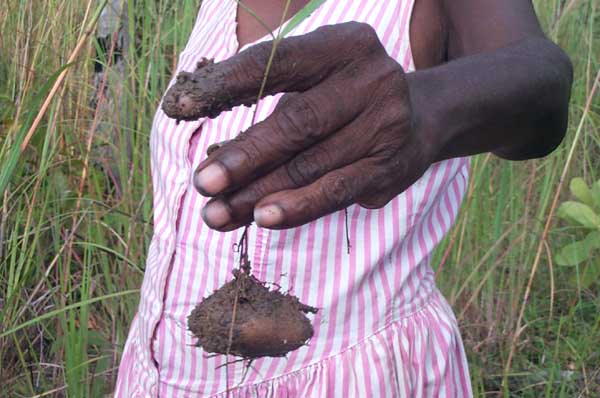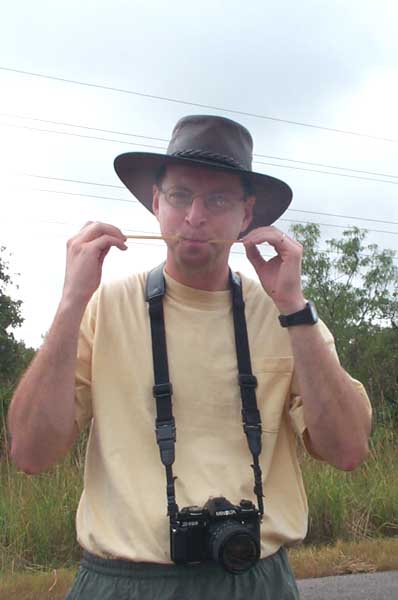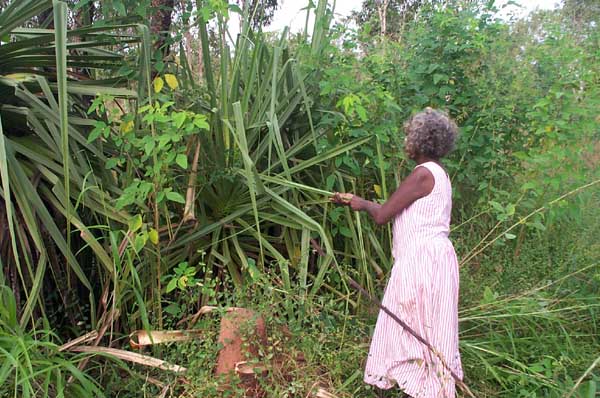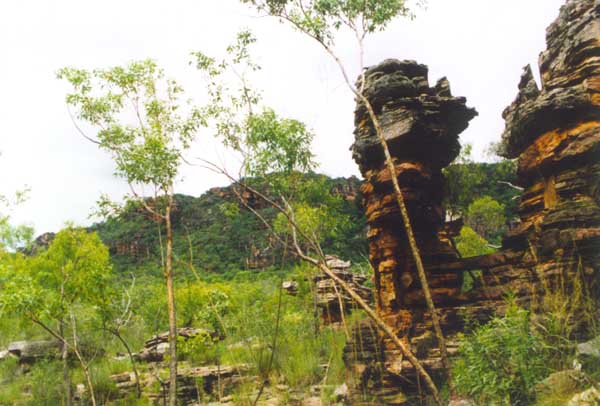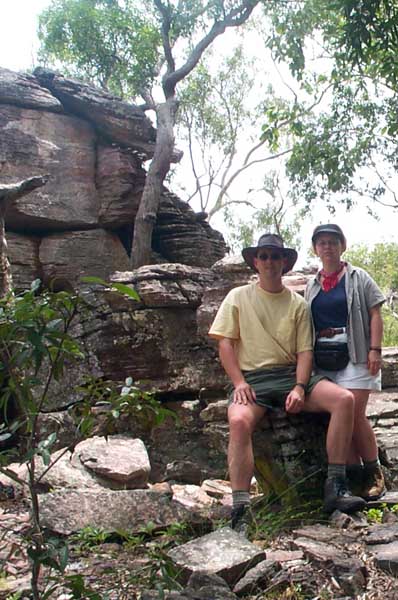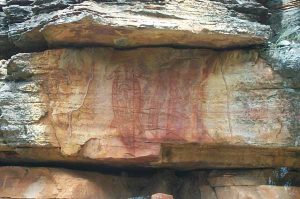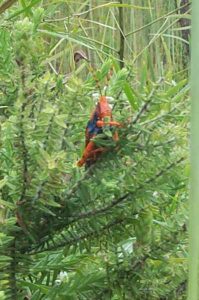Ah, luxury. We were able to sleep until 7:00 and still had ample time to prepare for our 8:00 departure for the day’s tour. The lorikeets were still yelling. We managed to sleep through their racket, but we felt there must be a mountain of plastic crystals outside by then.
The tour company offers one-, two-, or three-day packages into Kakadu. They work the transportation so that every bus stays in the park one night. If you are on a one-day tour, you ride into the park on one bus, stay on it all day, then take another bus back to Darwin. That bus is returning from a two-day tour. If you are on a two-day tour, you ride into the park and out of the park in the same bus, staying with it the entire time. If you are on a three-day tour, as we were, you ride into the park on one bus, stay on it all day, have a much more personal tour on the second day — no bus, just a 4WD SUV — then spend the third day on the back end of a two-day tour.
We were on our second day, and there were only six tourists signed up for that particular three-day excursion. There was a couple from Northamptonshire, England, two girls from Finland, then Chris and me. Our guide for the day was a man named Yuri. He picked us up in a Toyota 4WD and we were off. We were joined in the morning by an Aboriginal woman named Gladys. She was probably in her 60’s, but it is hard to tell exactly. She grew up in the bush and knows which plants have edible parts during each season. She is also a skilled weaver, making baskets and mats that are sold in the local shops.
Gladys didn’t say much, but she demonstrated how the bush-dwellers gather food, prepare pandanus leaves for weaving, find dye plants, and make string. Yuri would stop the truck beside the road, then Gladys would look around in the tall spear grass, finally saying something like “Here,” then “Yams.” We would all walk to where she was and she would dig up a plant with a blunt machete, then hand the root or tuber to Yuri.
He would explain what the plant was, and Gladys would find a couple more. When we had enough for everyone to get a sample, Yuri would wash the dirt off and cut off pieces for us to taste. Nothing tasted awful, most of it tasting like raw potatoes or water chestnuts. We also tried some wild grapes that were sweet, but left a prickly feeling in the back of the throat. It went away after a few minutes, but was very odd.
One of the foods we tried was a type of Aborigine candy. Some of the spear grass has sweet-tasting juice in the part of the stalk just above the ground. Gladys found enough of the eight- to ten-inch stalk segments for everyone, then we just bit into it, sucking the juice out of the spongy insides. It was mildly sweet, and there was a surprising amount of juice in those little stalks.
Next we found a patch of spiral pandanus, a thin-leafed, bushy palm tree whose leaves grow in a spiral around the main trunk. Gladys chose some new leaves and pulled them out of the plant. At the base of the leaf cluster was another edible plant part: heart of palm. It tastes like cabbage. The main reason for gathering the leaves wasn’t for food, though. It was to process them and make them into basket materials. Using a simple — but hard for us to perform — manipulation of the leaves, Gladys was able to peel the top layer of the leaf from the stiffer bottom layer. When that was done, she evened up the edges of the leaves and tied them in two bunches: one bunch for the soft top layer, another for the bottom layer. Both layers are used in weaving, but for different purposes. The stiff leaves are used for the “spokes” of mats and baskets. The more flexible leaves are used for the sides. When dried and dyed, the materials stay strong and flexible for years.
We weren’t finished with pandanus, yet. We found some sand pandanus, and again Gladys pulled out some leaves. Using a similar, but easier, process, she again layered the leaves. In this case she kept only the top layer of each leaf. When she had enough, she put three or four of the leaves together and started rolling them against her leg to make string. When she got close to the end, she just spliced in another group of leaves to make the string longer. The resulting string is strong and very flexible. It is used to make string bags through a process like crochet.
By the time we had seen all of these demonstrations, it was nearly noon. Yuri dropped Gladys off, and then we all headed for a picnic lunch by Jabiru’s lake. Yuri set up a buffet of sandwich fixings and we all dug in. While we were eating, we could hear almost constant bird calls that sounded like a depressed chicken. Each call was a long, drawn-out, whining cluck, coming from dozens of white cockatoo’s roosting in the trees around us and complaining about the heat.
This is probably a good place to tell how Kakadu got it’s name. In the mid-nineteenth century, the German explorer Ludwig Leichardt visited this area of Australia. Because of all of the cockatoos he saw, he named the area Kakadu, the German word for cockatoo. Leichardt later vanished while trying to cross from the eastern side of Australia to the western shore.
One of our English companions wasn’t feeling well, so Yuri dropped both of them off at the hotel, then the rest of us left for our afternoon adventure. Yuri took us four kilometers down a rutted, washed-out, muddy road to a large rock outcropping. The sandstone there predates life on this planet.
It has eroded in remarkable ways, leaving shelves and ledges of rock. In some cases, it has left a very large chunk of sandstone balanced on a much smaller piece, making it look like a giant mushroom of craggy rock.
Some of the more stable rocks had paintings on them. It was refreshing to see these paintings in such a remote place, without the stairs, walkways, and protective railings that we saw at Nourlangie Rock.
From a vantage point in this remote rock field, we could see all the way across a broad plain to the cliffs that form the Arnhem Land Escarpment just north of Kakadu. Closer to the road, Yuri pointed out a bush that is the exclusive home of Leichart’s Grasshopper. These grasshoppers hatch during the wet season, mate and lay their eggs, then die off at the end of the Wet. They do all of this in or under a single species of bush. Another unique trait of these grasshoppers is their coloring: electric blue spots on a fluorescent orange body. Despite this coloring, birds leave them alone, and they have no known predators.
Yuri had promised us a swim, making sure that everyone had their swimming costume with them. It was time for him to make good on his promise. We were all hot and sweaty, and the humid air provided no cooling. We drove back out the bumpy, slippery road, then to Anbangbang Billabong. As everywhere else, the billabong was swollen with flood waters. We walked around the billabong on a huge slab of conglomerate rock, finally arriving at a rain-fed pool, out of reach of crocodiles.
We all climbed into the fresh water, clear except for a light tea color leached from plants upstream. Despite the color, the water was clean enough to drink (according to Yuri), and refreshing at about 85 degrees Fahrenheit. That was about 10 degrees lower than the air temperature. The sandy bottom was easy on our feet, and we splashed around, cooling off for about twenty minutes. We then grabbed our gear and walked a short distance to another pool, fed by the same stream. After a little while there, we waded farther down the stream, back to the rock face we had traversed earlier. The refreshed feeling didn’t last long. Before we were back to the truck, we were all hot and sweating again.
It had been a busy day. After a shower, we headed for dinner. I was exhausted and could barely stay awake. Afterward, we decided we would have enough time to pack in the morning and went to bed at 8:30.

